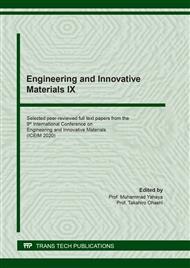p.29
p.35
p.43
p.49
p.57
p.63
p.71
p.77
p.83
The Effect of Stirring Tool Surface Condition on Wear Characteristics in Friction Stir Welding (FSW) Process
Abstract:
Stirring tool is one of the important factor that contribute to the successful of Friction Stir Welding (FSW). Role of tool, is to heat the welding zone and stir the material along the process. Many studies have been conducted by other researchers to improve the performance of stirring tool. Similar to this work, it is aimed to investigate and analyze the effect of stirring tool surface condition on wear characteristics in friction stir welding process. Four tools have been fabricated with pre-determined surface condition. Tool 1: H13 without heat treatment and without coating. Tool 2: H13 with heat treatment only. Tool 3: H13 with TiCN coating only and Tool 4: H13 with heat treatment and with TiCN coating. Friction stir welding was performed to test and verify the performance of fabricated tools. Process parameter used are 1270 RPM for rotating speed while 218 mm/min for welding speed. From the result, Tool 4 performed better in terms of physical wear as well as wear rate.
Info:
Periodical:
Pages:
57-62
Citation:
Online since:
March 2021
Keywords:
Price:
Сopyright:
© 2021 Trans Tech Publications Ltd. All Rights Reserved
Share:
Citation:


